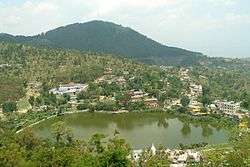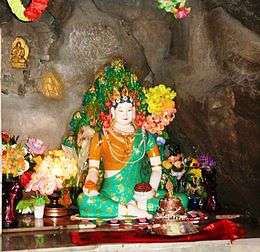Rewalsar Lake
| Rewalsar Lake | |
|---|---|
 | |
| Location | Mandi district |
| Coordinates | 31°38′02″N 76°50′00″E / 31.63389°N 76.83333°ECoordinates: 31°38′02″N 76°50′00″E / 31.63389°N 76.83333°E |
| Type | Mid altitude lake |
| Basin countries | India |
| Shore length1 | 735 m (2,411 ft) |
| Surface elevation | 1,360 m (4,460 ft) |
| References | Himachal Pradesh Tourism Dept. |
| 1 Shore length is not a well-defined measure. | |
Rewalsar Lake is a mid-altitude lake located on a mountain spur in the Mandi district, 22.5 km south-west from Mandi, in India. Its elevation is about 1,360 m above sea level.
The lake is shaped like a square with the shoreline of about 735 m. It is held as a sacred spot for Hindus, Sikhs and Buddhists.[1][2]

There are three Buddhist monasteries at Riwalsar. The lake also has three Hindu temples dedicated to Lord Krishna, Lord Shiva and to the sage Lomas. Another holy lake, Kunt Bhyog which is about 1,750 m above sea level lies above Rewalsar.[3] It is associated with the escape of 'Pandavas' from the burning palace of wax—an episode from the epic Mahabharata.
It was from here that the Indian teacher and 'Tantric' Padmasambhava left for Tibet. Known to the Tibetans as 'Guru Rinpoche', the Precious Master, it was under Padmasambhava's influence that Mahayana Buddhism spread over Tibet. There are islands of floating reed on Rewalsar lake and the spirit of Padmasambhava is said to reside in them. It is here that the sage Lomas did penance in devotion to Lord Shiva, and the Sikh guru Gobind Singh (22 December 1666 – 7 October 1708), the tenth Guru of Sikhism, also resided here for one month.
The Sisu fair held in late February/early march, and the festival of Baisakhi are important events at Rewalsar.
Legend of Padmasambhava and Princess Mandarava of Mandi (Zahor)
Mandarava and Padmasambhava were energetically drawn to one another. Vihardhara, fearful of the contamination of the royal bloodline and what he perceived as Mandarava's apostasy, endeavoured to have Mandarava and Padmasambhava purified by immolation through the flames of a pyre. Instead of finding their corpses incensed and charred, Vihardhara finds that the fire of the pyre has been transformed into Lake Rewalsar, out of which arises a blooming lotus that supports the unharmed Mandarava and Padmasambhava who through this manifestation of their realisation have achieved their secret names of Vajravarahi and Hayagriva, respectively, after which Vihardhara furnishes the union with his unreserved blessings.
Legend has it that the great teacher Padmasambhava (Guru Rinpoche) used his enormous power to take flight to Tibet from Rewalsar. In Rewalsar, his spirit is said to reside in the tiny island of floating reed that drifts over the water.
Statue of Padmasambhava

On April 1, 2012, a monumental statue of Padmasambhava, measuring 37.5 m (123 ft), was consecrated, blessed and inaugurated by the 14th Dalai Lama. The building project was spear-headed and overseen by Wangdor Rinpoche and funded by donations. It took nearly 10 years to complete, with the foundation alone taking three years.[4]
The statue was constructed almost entirely by hand by tradespeople from the immediate Rewalsar area and by master artists from Nepal and Bhutan. It is made primarily of cement, layered by hand over a skeleton of iron rebar, while the walls are made of hand-cut stone. Bhutanese sculptors carved intricate details into the cement while still wet. It was then painted by masters from Nepal, who finished the delicate details by hand. The building's interior is filled with traditional dzong, tsa tsas, prayer flags and medicine pills made by local craftworkers.[4][5]
See also
- Rewalsar, India, a village located beside the lake
Footnotes
- ↑ Emerson (1920), p. 203.
- ↑
- ↑ himachaltourism.gov.in
- 1 2 "Wangdor Rimpoche: Padmasambhava Project". www.customjuju.com. Retrieved 2018-07-30.
- ↑ "Guru Rimpoche Statue". Flickr. Retrieved 2018-07-30.